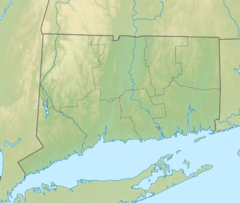Tomlinson Lift Bridge
| Tomlinson Lift Bridge | |
|---|---|

Tomlinson Bridge from Criscuolo Park, New Haven, just beyond the original Q Bridge of Interstate 95.
|
|
| Coordinates | 41°17′54″N 72°54′19″W / 41.298296°N 72.905292°WCoordinates: 41°17′54″N 72°54′19″W / 41.298296°N 72.905292°W |
| Carries | four lanes of |
| Crosses | Quinnipiac River |
| Locale | New Haven, New Haven County, Connecticut, United States |
| Owner | ConnDOT |
| Characteristics | |
| Design | Vertical-lift bridge |
| Material | steel |
| Total length | 283.5 metres (930 ft) |
| Width | 28 metres (92 ft) |
| Longest span | 82.3 metres (270 ft) |
| History | |
| Designer | Hardesty & Hanover, LLP |
| Engineering design by | Nicholas J. Altebrando, Thomas A. Duffy, Michael D. Hawkins, Timothy J. Noles |
| Construction start | 1922 |
| Construction end | 1797, 1885, 1924, 2002 |
| Construction cost | USD$125,000,000 |
The Tomlinson Lift Bridge is a crossing of the Quinnipiac River in New Haven, Connecticut. The bridge forms a segment of U.S. Route 1. The Tomlinson Vertical Lift Bridge carries four lanes of traffic across New Haven Harbor and a single-track freight line owned by the Providence & Worcester Railroad that connects the waterfront with the Northeast Corridor line of Metro North and CSX. A sidewalk is present along the southern edge of the bridge.
The first bridge here was erected in 1797 by Isaac Tomlinson's group to replace profits from their ferry ruined by a new bridge. This 27-foot (8.2 m)-wide covered wooden truss bridge included a draw to allow vessels through. It has also been described as a "wood and sandstone" bridge.
The second bridge, 1885-1922, was an iron bridge which was never particularly good, having been salvaged from a scrap yard, and not thought well of even before then. By 1913, this bridge was opening 17,000 times a year. Plans for replacement were created during World War I.
The third bridge on-site was a trunioned double-leaf bascule drawbridge with its counterweights in a closed pit underneath, built between 1921 and 1924. It was designed by engineer Ernest W. Wiggin of New Haven in the Beaux-Arts style, based on a bascule design by Joseph B. Strauss. Before the completion of the adjacent Q Bridge, it was carrying 30,000 vehicles a day. When closed, clearance under the bridge was 12 feet (3.7 m) at mean high water, ranging from 8–17 feet (2.4–5.2 m) at extreme high tide to extreme low tide. The channel width was 117 feet (36 m), with a total span length between centers of 148 feet (45 m). The builder was the Phoenix Bridge Company of Philadelphia, Pennsylvania.
...
Wikipedia

